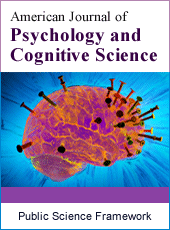American Journal of Psychology and Cognitive Science
Articles Information
American Journal of Psychology and Cognitive Science, Vol.1, No.2, Jun. 2015, Pub. Date: May 26, 2015
Psychosocial Impacts of Disasters
Pages: 44-47 Views: 5441 Downloads: 1527
[01]
Syed Sajjad Nasir Kazmi, National University of Sciences and Technology, Islamabad, Pakistan.
[02]
Faisal Naeem Khan, National University of Sciences and Technology, Islamabad, Pakistan.
[03]
Hina Liza Malik, National University of Sciences and Technology, Islamabad, Pakistan.
[04]
Arshad Ali, National University of Sciences and Technology, Islamabad, Pakistan.
The world population today is touching 7.6 billion; [1]. It concludes the fully developed, developing and under developed countries. Those which have made significant development and had the little awareness about the disasters have surfeited lesser impacts of disasters than those which are still developing or under developed. Actually, the disasters also vary with respect to their nature and extent with regards to the losses these cause, to the infrastructure, population and the area covered. The related severity is also measured in the same context irrespective, the disaster was manmade or natural. Well familiar disasters at the global level had been the Indian Ocean Tsunami (2004), Earth Quake-EQ Pakistan (2005), US Katrina (2005), Myanmar Cyclone Nargis (2008), Pakistan’s Flood (2010), North American EQ Haiti (2010), most recently The Indian Ocean Tsunami Nelofer (2014) and very importantly the Global War on terror since 2001 till date. Very recently the “School Terrorism” incident of Peshawar, Pakistan on 16th December 2016 has almost shaken the entire world. All such disasters have various vulnerabilities attached to it but worth mentionable are the socioeconomic, geostrategic, politico military, psychosocial and attitudinal vulnerabilities. Each one of it has a vital role to play while finding out its impact. Among all the least preferred but most lethal and disastrous is the psychosocial vulnerability. The study at length is suggestive to discuss and highlight in detail the psychosocial impacts of the disasters while recommending certain measures to mitigate such vulnerabilities. A holistic approach had been used to view the psychosocial impacts of Nowshera, Pakistan Floods (2010) and Muzaffarabad EQ (2005). “School Terrorism” incident of Peshawar, December 2016 on the affected communities settled at Nowshera, Peshawar and surroundings.
Disasters, Impacts, Psychosocial, Communities, Vulnerabilities
[01]
Economic survey (2011-2012).
[02]
Erik Erickson, "Theory of Psychosocial Development" pp. 2, (1984).
[03]
The American Academy of Child and Adolescent Psychiatry -AACAP, (1998).
[04]
Billig; "National Mental Health Services Knowledge Exchange Network" pp. 30, (1993).
[05]
Gul, Imtiaz. The Al Qaeda Connection. London UK: Penguin Global, 2010.
[06]
Hussain, Zahid. Front Line Pakistan; The Struggle with Militant Islam. Pakistan: Columbia University Press, 2008.
[07]
Butler; "American Psychiatric Association" pp.32, (1987).
[08]
Mushtaq, Khalid. Health issues of internally displaced persons in Pakistan. USA: Published, American Journal of Disaster Medicine, March 2010.
[09]
PSSP Seminar in Washington DC: Addressing the Needs of Internally Displaced Persons in Pakistan.
[10]
Aarts; "National Institute of Mental Health and Neuro-Sciences" pp.2, (2001).
[11]
World Health Organization Report (2008).

ISSN Print: 2381-7453
ISSN Online: 2381-747X
Current Issue:
Vol. 6, Issue 2, June Submit a Manuscript Join Editorial Board Join Reviewer Team
ISSN Online: 2381-747X
Current Issue:
Vol. 6, Issue 2, June Submit a Manuscript Join Editorial Board Join Reviewer Team
| About This Journal |
| All Issues |
| Open Access |
| Indexing |
| Payment Information |
| Author Guidelines |
| Review Process |
| Publication Ethics |
| Editorial Board |
| Peer Reviewers |


